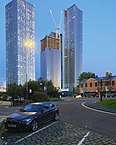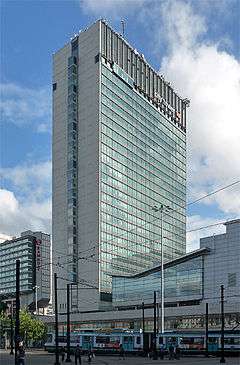People's History Museum
The People's History Museum (the National Museum of Labour History until 2001) in Manchester, England, is the uk's national centre for the collection, conservation, interpretation and study of material relating to the history of working people in the UK. It is located in a grade II-listed, former hydraulic pumping station on the corner of the Bridge Street and Water Street designed by Manchester Corporation City Architect, Henry Price.[1][2][3]
The People's History Museum | |
 The location of the museum within Manchester | |
| Former name | National Museum of Labour History |
|---|---|
| Location | Manchester, United Kingdom |
| Coordinates | 53.481389°N 2.253333°W |
| Type | History museum |
| Architect | Henry Price |
| Website | www |
The museum tells the story of the history of in Great Britain and about people's lives at home, work and leisure over the last 200 years. The collection contains printed material, physical objects and photographs of people at work, rest and play. Some of the topics covered include popular radicalism, the Peterloo Massacre, 19th century trade unionism, the women's suffrage movement, dockers, the cooperative movement, the 1945 general election, and football. It also includes material relating to friendly societies, the welfare movement and advances in the lives of working people.
History
The Trade Union, Labour and Co-operative History Society operated a collection at Limehouse Town Hall between 1975 and 1986, with the bulk of the collections in storage. The museum moved to Manchester and re-opened in 1990 at the Grade II* listed former Mechanics' Institute at 103 Princess Street.[3][4]
In 1994, the museum opened the Pump House People's History Museum containing a public gallery at the present site on Bridge Street. The two sites were renamed the People's History Museum (PHM) in 2001.[3] The Bridge Street site closed for a £12.5m redevelopment in October 2007.[5] The redevelopment included the refurbishment of the existing Pump House and the construction of a four-storey extension alongside it. A glass walk way was constructed to link the two buildings.[6] The museum reopened on 13 February 2010.[7][8]
The new building houses the museum galleries, changing exhibitions, education service, Labour History Archive and Study Centre (formerly at 103 Princess Street), Textile Conservation Studio, corporate facilities, café and shop. The new People's History Museum has more coherent museum galleries designed to display the collection with improved interactive exhibits and interpretation.
A larger, temporary exhibition gallery allows more of the museum's own collections to be seen, as well as topical national touring exhibitions. A dedicated community gallery provides local people with a space to display their own work while the integration of the Labour History Archive and Textile Conservation Studio allows visitors to see the museum's work.
Collection
The People's History Museum holds one of the largest collections of political material in Britain, beginning with the early 19th century. It focuses on the history of democracy with objects relating to the right to vote making up a large part of the objects on display. The collection includes 2,000 posters focused on elections and political campaigns, 300 political cartoons, 7,000 trade union badges and tokens, as well as 95,000 photographs.[9] With over 400 trade union and political banners, People's History Museum holds the largest banner collection in the world[10] and visitors to the museum can see banners being conserved in Main Gallery Two in the Textile Conservation studio.[11]
The museum actively collects contemporary material. Through projects such as "Play Your Part", the museum makes the historic collections relevant to present day issues.
PHM also houses the Labour History Archive and Study Centre, an important archive of material relating to the history of working people in Britain. Its collections include the archives of the Labour Party, the former Communist Party of Great Britain, the co-operative movement and the Department for Work and Pensions. It also contains documents relating to Chartism, general elections, the First World War, women's suffrage and the 1984–1985 miners' strike.[12]
References
- Former Hydraulic Power Station in Grounds of City College, Heritage Gateway, retrieved 28 February 2010
- Field, Corinne (16 August 2004), Pump Up The Volume – Manchester Hydraulic Heritage, Culture 24, retrieved 28 February 2010
- Little, Steve, Conservation Plan The Pump House – People's History Museum, Bridge Street, Manchester (PDF), Manchester City Council, archived from the original (PDF) on 2 October 2011, retrieved 28 February 2010
- 103 Princess Street, Heritage Gateway, retrieved 28 February 2010
- Haile, Deborah (19 January 2008), People's museum wins cash boost, Manchester Evening News, retrieved 28 February 2010
- Bosley, Kirsty (31 July 2008), Glass walkway to restoration, Manchester Evening News, retrieved 28 February 2010
- People's History Museum set to re-open, Manchester Evening News, 19 February 2010, retrieved 28 February 2010
- History, People's History Museum, retrieved 28 February 2010
- Introduction To Our Collection, People's History Museum
- Our Collection, Banners, People's History Museum
- Textile Conservation Studio, People's History Museum
- Collection Catalogues and Descriptions, Labour History Archive and Study Centre, archived from the original on 13 January 2015, retrieved 13 January 2015
Further reading
- Gibbs, Caroline (1980), "The National Museum of Labour History", History Workshop Journal, Oxford University Press, 10 (1): 191–193, doi:10.1093/hwj/10.1.191
- Bird, Stephen (1994), "A Specialist Labour History Archive The National Museum of Labour History Archive Centre", History Workshop Journal, Oxford University Press, 37 (1): 170–176, doi:10.1093/hwj/37.1.170





